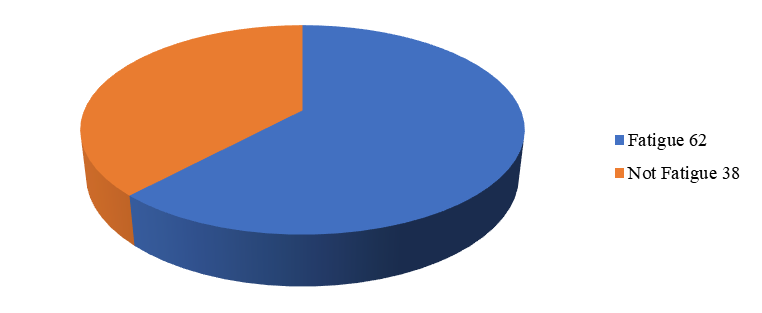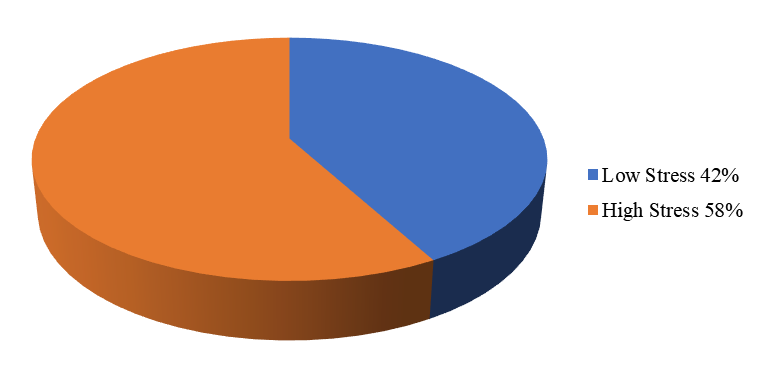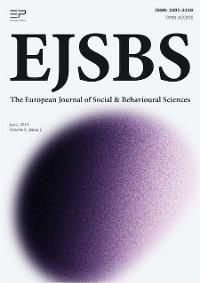Relationship Work Fatigue Related to Work Stress on Circadian Rythm Night Shift Operator Employee PT. Indonesia Bulk Terminal Kotabaru, South Kalimantan, Indonesia
Abstract
Background Excessive workload can cause not only physical fatigue, as well as the emotions which then become a source of stress. Fatigue is a factor that may impede the achievement of productivity. Physical fatigue, mental, and emotional stress suffered due to long periods of time due to the high productivity demands. Aims Determine the relationship of fatigue to the stress of working on the night shift employees at the operator. Methods Observational analytic cross-sectional approach. The study population was all part of the service employees at PT. IBT as many as 130 employees of the operator. The research sample was taken by using purposive sampling as many as 97 people. The research instrument used in this study was a questionnaire fatigue and work stress. Results The level of employee fatigue as much as 62% exhausted, to the level of work stress 58% stress level is high. Work stress and relationships based on employee fatigue 72% exhausted. Conclusions There is a relationship to work stress fatigue on operator night shift employees. Suggestion alternate shift pattern and shift off before. Giving out bond program for employee. In order to create a new atmosphere and relaxed and a sense of togetherness and belonging. So that productivity increases as well as health and safety realized.
Keywords: Fatigue, job stress, employee service, night shift, IBT
Introduction
Night shift worker adaptability to changing circadian rhythms influenced by environmental factors (Martiana,1999). Work rotation system commonly applied, then the coal mine workers have the same risk for decreased immune response due to changes in circadian rhythms. Work environment in a more closed mine very big influence on the speed of the decline immune response.
Circadian rhythm closely related to melatonin levels. Circadian rhythm directly influence the normality of melatonin levels that naturally in the body. Melatonin is a hormone that normally can be found in animals, humans and other organisms (Reiter et al, 2001). Naturally, melatonin have the ability as an antioxidant. Unlike other antioxidants, the role of melatonin as a natural antioxidant in the human body is closely related to the elimination of free radicals (oxidants) and assist in the recovery of the negative effects of inflammation. Melatonin activity of as a antioxidant start to be a concern since of these substances are known oxidized through the photocatalytic mechanism involving free radical (Hardeland & Fuhrberg, 1996). Fatigue can reduce working capacity and endurance of work that characterized by the sensation of fatigue, decreased motivation, decreased activity. If there is no balance between the physical and mental work will lead to decreased of concentration, ability, and effectiveness. These are the signs of fatigue and exhaustion that continues lead to work stress.
Time to restore the freshness from fatigue that caused by work to be an important part in the preparation of the work shift. This involves schedules and working hours. According to Jensen, et al (2003), and the schedule of working hours will be related to the needs of the freshness restore differ between men and women. According to Berger and Hobbs (2006), to reduce the error rate suggested doing naps in night shift workers, eliminating overtime over 12 hours and up to the task before 4 am for night shift. According to Galinsky, et al (2000), time off can also reduce musculoskeletal discomfort (MSD), eye disorders, mood and performance of workers.
Problem Statement
According to Arsenault and Dolan (1983) that work stress is an unpleasant psychological condition that arising because employees feel threatened, which is characterized by a mismatch between the individual and the demands of the job. Work stress is distress experienced by employees in dealing with the work. Work stress is evident from the symptoms, such as emotional instability, feelings worried, aloof, sleeplessness, excessive smoking, cannot relax, anxiety, tension, nervousness, increased blood pressure, and digestive disorders. Sources of physical stress associated with the physical environment, such as lighting, noise, vibration, and so on. Sources of psychosocial stress related to environment of social organization. Sources of stress are included in this category include organizational climate, management style, job design, and role conflict.
Based on preliminary observations, there are 54 employees of the operators that are divided into three groups that rotate in 2 shifts. Interview results suggest that almost majority operator experienced fatigue so this study wanted to determine the effect of work fatigue with work stress on the operator employees of PT. Indonesia Bulk Terminal (IBT) Mekarputih pulau Laut Kotabaru South Kalimantan Indonesia.
Research Questions
Is there a relationship of work fatigue with work stress on employees of the operator PT. Indonesia Bulk Terminal (IBT) Mekarputih Kotabaru South Kalimantan Indonesia.
Purpose of the Study
Determine the effect of work fatigue with work stress on employees of the operator PT. Indonesia Bulk Terminal (IBT) Mekarputih Kotabaru South Kalimantan Indonesia.
Research Methods
Research design using observational analytic type, cross sectional approaching method. The research population is all employees of the operator ,130 people. The research sample of respondents was taken by purposive sampling techniques were 97 employees with the operator inclusion criteria. Research instrument. using a questionnaire. The tool of work fatigue feelings measurement to measure feelings of work fatigue. And work stress scale for measuring the level of work stress. Variables in this research using independent variables employee work fatigue. Work fatigue scales with a nominal scale. And the dependent variable was work stress on employees. Scale used nominal scales. Research procedure begins with a preliminary survey to obtain information the number of operator employees and determine the condition of the working environment. Getting started with the selection of employees with purposive sampling method according to desired criteria, prepare the questionnaire that will be used to measure the level of work fatigue and work stress levels that experienced by operator employees, validity and reliability test of the questionnaire to 30 operator employees were not being research respondents. By providing the questionnaire and testing the validity and reliability.
The implementation of work fatigue level and work stress levels measurement by distributing questionnaires to each respondent. Once the data is collected, performed data classification and data analysis. Data reported after the data collection done, then the data is processed and made into reports.
Techniques of data collection and processing data, obtain the primary data through the use of questionnaires for measuring work fatigue and work stress measurements. Data was collected through a questionnaire distributed directly to the respondent, then the respondent to answer by filling in the questionnaire that was given. Secondary data include the number of personnel and employees.
Method of data analysis is univariate and bivariate analysis, Fisher's Exact Test as statistical test with a 95% confidence level using a computerized program. Time and place of research in 2012 at PT. Indonesia Bulk Terminal (IBT) Mekarputih Pulau Laut Kotabaru South Kalimantan Indonesia.
Findings
The work rotation in shift workers deviates toward conventional forms of human activity experience the peak during the day and evening. Deviation of the daily activity puts time shift workers at the opposite a natural condition of human function that oscillates in a 24-hour period. Natural function which includes the physiological processes (e.g. metabolic rate), psychological processes (e.g., short-term memory) and social processes (e.g., interactions with family) it all known to increase and decrease rhythmically throughout daily activities. This form is known as the circadian rhythm (Ghiasvand, 2006). In night shift workers circadian rhythms of the body normally diurnal (Bear, 1996) will be transformed into nocturnal (Harrington, 1994). Disruption to the circadian rhythm may lead to disrupt synchronization of natural functions that affect the health condition of the body.
Work Fatigue levels on Operator Section Employee
Fatigue is a condition of the individual body or employees who experience feelings of fatigue during or after the work so it can degrade the performance and productivity of employees. The following results of research on work fatigue based on the results of the questionnaire (see table 1 & Figure 1).

The operator employees are the most who experienced fatigue during strenuous work because of the nature of their job are overseeing, monitoring and checking the machines at work and fixing tools when the damage occurred.
Internal factors that cause work fatigue such as age, gender, nutrition, physical factors, health, and others. External factors causing fatigue is such of physical work environment (noise, temperature, lighting, chemical factors / toxic substances, biological factors (bacteria, fungi), ergonomic factors, job categories, nature of work, discipline or company regulations, wages, social relations and working status.
Work Stress Levels on Employee Operator Section
Work stress is a state of body condition experienced tension or stress that affects a person's emotional and conditions at work and after work. The following results of research on work stress based on results a questionnaire on employee operator (see table 2 & Figure 2).

Work stress experienced by operator employees mostly classified as high stress, because at the time the employee worked operator working hard at work supervise, monitor and check the machines at work and fixing the tools when there is damage and make sure the coal pile in the correct place. This will make the employee operator become stress that may cause drowsiness and lethargy due to physical activity and imposes on the mind. Employees may experience tension in which the operator have to monitor the passage of the machines or equipment carefully so that the concentration will continue to take place which will then cause the nerve to be strained so it can be stressful. Work stress appears on the symptoms, such as emotional instability, feelings of calm, aloof, sleeplessness, excessive smoking, cannot relax, anxiety, tension, nervousness, increased blood pressure, and digestive disorders.
The relationship between work stress to work fatigue on employee operator
Factors that affect fatigue there are two internal factors and external factors. Internal factors which include, factors somatic or physical factors, nutrition, sex, age, knowledge and attitude or lifestyle. While including external factors is the physical state of the working environment (noise, temperature, lighting, chemical factors (toxic substances), biological factors (bacteria, fungi), ergonomic factors, job categories, nature of work, discipline or company regulations, wages, social relations and working position or positions.
Based on the statistical test using Fisher's Exact Test obtained the expected frequency value is less than 5, then the p-value from Fisher's Exact Test used the p-value of 0:03. This p greater than α = 0.05 Ho rejected concluded that mean there is a relationship between work fatigue work stress for employees with section operator. There are two factors that contribute to stress in the workplace sources of organizational and extra-organizational stress. Organizational sources of stress is the source of the stress that comes from the physical environment organizations such as lighting, noise, vibration, and so on and derived from the organization's social environment such as organizational climate, management style, job design, and role conflict. While the extra organizational source of stress is the stress factor sourced on the job such as job demands, individual characteristics, outside organizations such as family problems.
Based on the characteristics of the respondents by age operator employees are internal factors that can affect the fatigue of work and workers in the productive age are not emotionally stable. So that the views of the age factor can affect work stress. Characteristics of the respondents according to the period of employment of an external factor causes fatigue that environmental factors such as climate, noise levels and the risk of occupational hazards.
Results of measuring the level of operator fatigue on employees some employees experienced operator fatigue due to the nature of the heavy work. However, the results of measurements of employee stress levels experienced provider of high stress. This is consistent with the level of fatigue experienced by operator employees. Operator Fatigue level is directly proportional to the stress of work, is also influenced by other factors in the work unit high noise, heat, shelter areas away from work, family relationships apart, the high economic level in the workplace, relationship at work and physical demands working at a large risk of danger so as to increase the level of stress experienced by employees of the operator.
In this case the mechanism of decreased immune responses essential to be revealed because it can cause a decrease in the quality of physical labor workers in the next 5 years. Stress-induced changes in circadian rhythms are accepted by night shift workers are acute and recurrent. This stress can be the beginning of the onset of chronic disease (Roitt, 1994), since the worker is a group that is vulnerable to a variety of exposure of the chemical and physical factors. Exposure to chemical and physical factors for the mutual support of impaired occupational diseases (Bos, 1995).
Various body function disorder associated with changes in circadian rhythm sleep disorders include (Niedhammer, 1994), digestive disorders, psychosomatic disorders (eg, negative feelings), impaired body temperature, fatigue and decreased alertness (Jaffe, 1996). Impaired function of the body is the result of endogenous changes in behavior that is accepted as a cause of stress (Kern, 1995). This happens because the body is unable to maintain homeostasis. The ability of the body to maintain homeostasis varies, depending on the ability to control and manage the change that is felt (Notosoedirdjo, 1998). When night shift workers are able to manage themselves to undertake prevention efforts, there will be a process of adaptation (Carlson, 1994). Body normally has the ability to maintain homeostasis through regulation and neurohormonal systems in accordance with the plot (Bear, 1996). Night shift worker adaptability to changing circadian rhythms also influenced by environmental factors (Martiana, 1999). At companies with a high enough degree of environmental pollution, pollutants that are inhaled and settles in the body of workers will affect the body's chemical processes. Chemical mechanism of the effect of environmental pollutants on the immune response shift workers is unknown, but is highly toxic pollutants that can damage the liver and kidney function (Sax, 1989), which in turn affect the immune response system. Coal mine workers are workers who are in an environment of intense polluting coal dust. Working with general rotation system is applied, then the coal mine workers have the same risk for decreased immune response due to changes in circadian rhythms. Work environment at the mine will be closed very big influence on the speed of the decline immune response.
In the period of time forward is necessary programs to cope with work fatigue as a work environment that is free from harmful substances, adequate lighting, adequate air setting, free from noise, vibration, and discomfort, general health is maintained and monitored, provided recreational facilities, leisure time and rest well done, leave and holidays should be best organized, and given special attention to certain groups such as the different workforce age, pregnant and lactating women, the labor force working in the night shifts, new power transfer. Programs for cope with work stress level such as the selection and placement of work in accordance with the capability, engineering re-work, welfare programs, working time management, and improved worker health, out bond recreation, morning gymnastics, community service, inter-division competition on occupational safety and health. This study has several limitations, namely lack of research time and distance are far too serious research respondents in filling out the questionnaire accordingly.
Conclusions
This study that the level of fatigue in the largest number of employees are tired. Experiencing stress level and high-level work. Stress and fatigue can be caused by a decreased immune response due to circadian rhythms change in the night shift. While time during the employee cannot take a break because influenced by light and rhythm of the body itself.
Acknowledgements
The author(s) declare that there is no conflict of interest.
References
Anggraeni R. (2011). Relationship between work fatigue with work stress of nurses in hospitals BLUD Boejasin Pelaihari. Thesis. Lambung Mangkurat University.
Gross, S., Semmer, N. K., Meier, L. L., Kälin, W., Jacobshagen, N., & Tschan, F. (2011). The effect of positive events at work on after-work fatigue: they matter most in face of adversity. The Journal of applied psychology, 96(3), 654–664. DOI:
Maurits, S. L., & Widodo, I. D. (2008). Factor and shift scheduling. Teknoin Journal, 13(2), 11-22. DOI:
Sholihah, Q. (2010). Coal Antioxidants. University of Malang Press.
Sholihah, Q. (2010). Effect of melatonin reduce levels of TNF-α, inflammatory cells in the broncho alveolar fluid lavace (BALF) rat rattus norvegicus Wistar strain which said coal dust in the evenings during the sub-acute. Proceedings of the national seminar master and doctoral programs. Faculty. Of Engineering Univ. Brawijaya Malang
Sholihah, Q. (2012.) Control of occupational health and safety (OHS) to prevent disruption of circadian rhythm by the caused damages resulting alveolar mice by night shift coal dust exposure. Journal of Applied JAEBS environmental and biological sciences, 2(11), 599-605.
Sihotang, I. N. (2004). Employee fatigue in terms of perception of the psychological work environment and gender. Psyche Journal, 1(1), 10-17.
Soetomo (1981). Tiredness (fatigue) in flight. Cermin Dunia Kedokteran, 24, 49-51.
Sunarni, T., & Istanti, V. (2007). Effect of work stress and work motivation on performance in PT. Interbis Sejahtera Palembang. Journal of Industrial Engineering, 7(2), 21-30.
Zaglafi, A. L. (2005). Effect of emotional exhaustion on work satisfaction and performance in the achievement of organizational commitment. Journal of Delegates, 1(4), 1-24.
Copyright information

This work is licensed under a Creative Commons Attribution-NonCommercial-NoDerivatives 4.0 International License.


